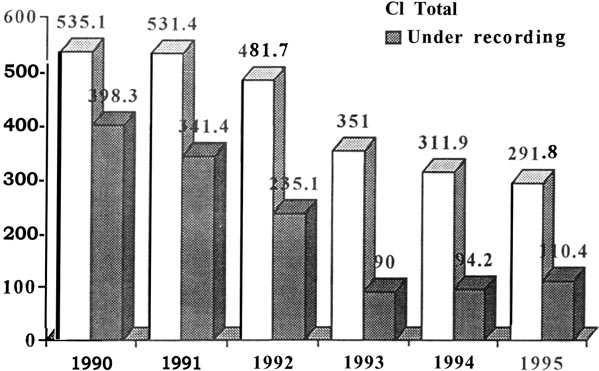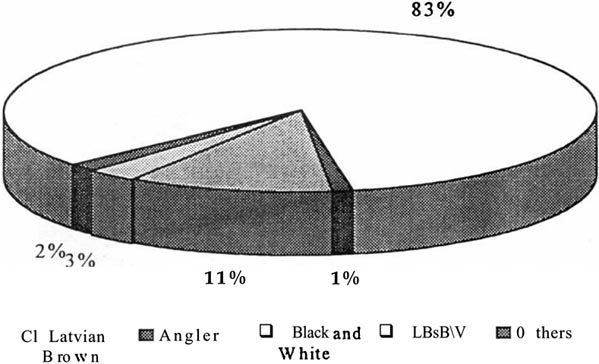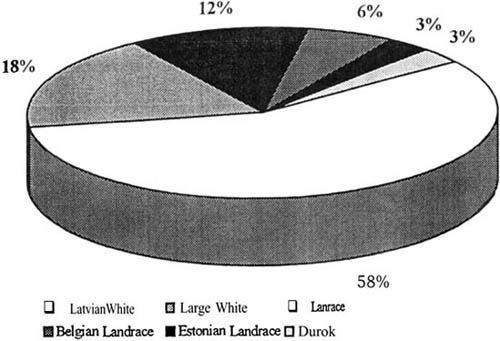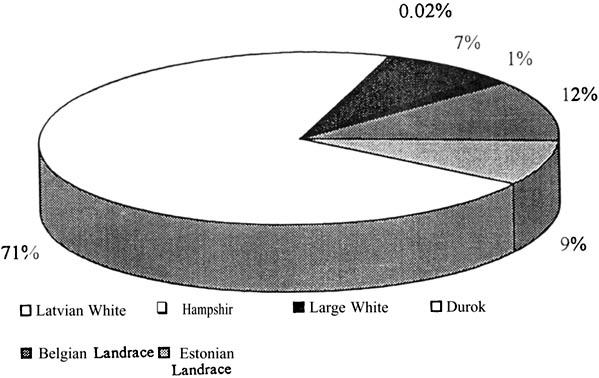D. Berke
Pedigree Animal Breeding Department, Ministry of Agriculture, Riga, Latvia
Livestock farming, processing and agro-service branches are of major importance in Latvian agriculture., During the transition period from centrally planned economy, agricultural product manufacturing acquired a particular role. The task of livestock farming is to produce the major commodities in sufficient.
When analyzing the situation in respect of livestock farming, one may come to the conclusion that ownership forms are undergoing intensive changes. Statutory companies are being liquidated and private farms are appearing; consequently livestock regrouping from public into private sector takes place. At the beginning of 1995, 55 % of pigs, 76 % of cows and 99 % of sheep from the total number of animals belonged to private farms.
In order to ensure the increase of livestock products production, intensification of this branch of agriculture plays a very important role. It could be achieved on the basis of a purposeful selection and by ensuring a co-ordinated state structure comprising cooperative organizations and individual farm activities.
Pedigree work concerning farm animals is performed in Latvia according programs which are designed by breeding associations and approved by the Agriculture.
Cattle breeding
Dairy cattle breeding was and still is one of the most popular livestock breeding branches in Latvia. Now it is not enough to simply raise animals only for the sake a quantity. It is necessary to focus on quality indices, in order to obtain products as cheap as possible which meet market requirements.
Selection work in cow breeding is performed by the Animal Breeders Association which was founded in 1993.
38 % of the total cow number Herd recording covers and during the last few years it has increased by 45 thousand head. A certain increase of productivity has also been achieved but unfortunately genetic potential of breeds is only partially utilized because there are many herds where animals are not assured to get abundant and balanced feed.
In the Republic there are two groups of breeds which are constantly raised and improved, i.e.: 83 % are Latvian Brown breed cows and 11 % are Black and White breed (diagram 2). A small number of Angler, Danish Red and Ayrshire breed cows are imported.
Total population amounts to 291 600 cows, of which 110 400 are subjected to milk recording. Bull dams are 400 and 100 young bulls are obtained per year, 50 of them are tested yearly, 30% are bull improvers and bull sires are 8.
For each bull testing 1500 semen doses are used and a minimal number of 50-60 daughters is considered.
The Latvian Brown breed is characterized by a fairly high milk yielding capacity: for young cows which have calved for the first time it is 4000-5000 kg, for grown up cows it is 5000-7000 kg and more and also the fat content is 4.0 - 4.3 %, and the protein content can reach 3.3 - 3.5 %. The Latvian Brown has also good meat properties; it is a good feed utilizer and this is an important prerequisite to ensure meat production efficiency.
Table I Average production
|
Breeds |
cows No. |
Milk kg |
Fat % |
Fat kg |
Protein % |
Protein kg |
|
Latvian Brown |
95.191 |
3.202 |
4.32 |
135.4 |
3.28 |
105.0 |
|
Angler |
1.391 |
3.202 |
4.31 |
138.0 |
3.30 |
105.7 |
|
Danish Red |
350 |
3.600 |
4.17 |
150.1 |
3.19 |
114.8 |
|
Ayrshire |
112 |
4.143 |
4.36 |
180.6 |
3.35 |
138.8 |
|
Black and White |
12.402 |
3.982 |
3.95 |
157.3 |
3.15 |
125.4 |
Breeding goals and program
The main breeding method used in cow breeding is pure breeding as well as crossing using unrelated breeds. For the improvement of Latvian Brown breed mainly kindred Danish Red and Angler breeder bulls were used. Recently, also unrelated Danish Red with Swiss blood, Holstein Red and White and Swedish Red and White bull semen were used, at present more the main impact is from Danish Red breed.
Table 2. Bulls in A.I. stations
|
Breed |
|
Number |
% from red breeds |
% from all breeds |
|
Latvian Brown |
pure-bred |
13 |
11.7 |
|
|
w/Danish Red breeds |
40 |
36.0 |
|
|
|
w/Angler breed |
10 |
9.0 |
|
|
|
w/Red and White Hoist. |
3 |
2.7 |
|
|
|
w/Swedish Red and White |
10 |
9.0 |
|
|
|
Sub total |
|
76 |
68.4 |
60.3 |
|
Angler |
|
12 |
10.8 |
9.5 |
|
Danish Red |
|
22 |
19.8 |
17.5 |
|
Total red breeds |
|
110 |
99.0 |
87.3 |
|
Black and White |
|
15 |
|
11.9 |
|
All breeds bulls together |
|
125 |
|
100 |
The breeding goal of Latvian Brown is:
- to raise milk yield up to 6000 kg per cow;
- to maintain protein level (3.3-3.5) characteristic of a proper breed;
- conformation: strong legs and feet, good attachment of the udder with correct teat position;
- good milkability and temperament.
Angler Breed from Germany were imported to AI stations and used intensively. In their progeny milk fat percentage increased considerably, also the milk yield to some extent, but the body mass of cows decreased substantially.
The Black and White population amounts to 8 % of the total cows population in Latvia.
The breeding goal is to continue improving Black and White cattle with Holsteins, using best bulls semen from all over the World. Since 1985 Holstein bulls are being used. The main selection character is milk protein yield. Good udder traits and milkability, also strong legs are needed. The production goal is more than 7000 kg milk, and 3.3% protein. In the future breeding program is planned to used more German sires.
Milk recording in Latvia is carried out according to the A and B type ICAR method. Milk is analyzed with respect to fat and protein, in some laboratories somatic cell counts are also controlled. We are planning this year to apply somatic cell count to all cows under herd recording programs as mastitis problem is rather acute.
At present time, in Latvia there are tree Artificial Insemination stations and one young bulls breeding station.
For bull testing the following criteria is used:
- milk productivity (kg);
- fat and protein (kg);
- conformation.
From 1991 the linear scoring of conformation traits was introduced (14 traits - 7 body, 7 udder).
From 1992 the reserve sire system was introduced (up to 20 % of bulls).
In 1993 the data processing center has been unduly privatized; since that time the previous data processing system ceased to exist and a new system had to be developed. It is also one of the reasons why we have not yet elaborated new breeding evaluation methods.
Pig breeding
In Latvia it is traditional that 40 % of the total meat consumption is pork. At the beginning of 1996, the pig number increased up to 552 600. At present 55 % of the total pig population is in the possession of private owners. It is impossible to speak about specialization in pig breeding as only 3 % of pig owners keeps more than 20 pigs. There are still 10 big pig fattening farms in operation with 7 1000 pigs, or 13 % of the total pig number.
Following a considerable reduction of pig number in 1993, as a consequence of economically ungrounded price relations between concentrate, energetic resources and final products, the pig number increased in 1994 and 1995 as there were more favorable conditions for piglet and pork sales.
Pedigree work in pig breeding branches is being performed by the co-operative organization "Selex" which was founded in 1991. The members of this organization are in total 33 pedigree pig breeding farms and pig fattening control stations.
The number of sows on breeding farms amounts to 12 % of their total number. At present there are 33 pig breeding farms engaged in raising various pig breeds through pure breeding method. The structure of breeds is shown in diagram. Some farms are simultaneously breeding and improving animals of two breeds. The Latvian White and the Large White breeds are used as "mother" breeds and Duroc, Hampshire as "father" breeds to improve fattening and meat quality properties.
The most widely-spread is Latvian White which is characterized by a strong frame, good acclimatization properties, high stress resistance and good reproductive ability (as an average it gives 10,6 piglets per litter). The volume of lean meat of the carcass should be increased and it can be achieved by using Yorkshire boars from Denmark and Sweden.
Table 3. Number of pig breeders by breeds
|
Breeds |
1992 |
1993 |
1994 |
1995 |
|
Latvian White |
14630 |
8025 |
8847 |
8506 |
|
Large White |
1809 |
916 |
1040 |
844 |
|
Landrace |
1405 |
422 |
655 |
708 |
|
Estonian Landrace |
434 |
464 |
480 |
1019 |
|
Duroc |
231 |
77 |
57 |
137 |
|
Hampshire |
|
|
|
54 |
|
Total |
18509 |
9904 |
11079 |
11268 |
In perspective, it is anticipated that the number of Latvian White will decrease, however, specialized breeding of meat pigs will increase and their utilization for meat production purposes as well. It is planned to set. up new Landrace, Duroc, Hampshire pig breeding farms however it is anticipated that several of the existing breeding farms will turn into interbreed crossing and hybridization farms which will distribute for fattening purposes hybrid pigs and animals resulting of two or three crossings.
We envisage to purchase breeding material abroad. Several new artificial insemination stations were established during the last two years and the number of artificially inseminated pigs at private and individual farms has considerably increased.
The main objectives of selection work in pig breeding are early pig maturity and improving feed utilization and meat quality. It is important to renew and maintain the genetic structure of pig breeds by enlarging the genofund and by ensuring useful improvement of the quality of breeding pig quality.
Pig testing at present is carried out with a control-fattening method. There are seven such stations operating in Latvia where 4800 pigs are evaluated each year. These stations work according to a joint method and they ensure the evaluation of animals kept on pig breeding farms in the country.
We are not satisfied with the present results in respect of growing intensity and meat quality (100 kg of live weight in 186 days, consumption of 3.40 feed units).
A new method has been designed (index method) for pig evaluation which we shall start using this year.
The most urgent tasks which should be carried out to ensure the stabilization of breeding work include:
- different pig breed crossing tests and comparing the results should be performed, in order to choose the best options;
- pig breeders interest should be roused to produce high quality pig meat with carcass classification according to lean meat content and a proper price fixing;.
- pig breeding data collection, processing and analyzing programs should be designed. a new method of breed-value determination should be designed.
The following problems are being faced:
- feed quality: mainly home-made feed is used which has a low protein content and do not ensure a balanced nutritional diet of the animals. That in turn results in a low growing intensity and pork is too fat;
- there is a lack of updating on production technology. That also hampers the intensification of production;
- an unbalance develops between fodder price and meat selling price.
Pedigree work subsidizing and the possibility of purchasing breeding animals for the money gained from subsidies, has played an important role.
Now feed grain stock in Latvia is limited and imported fodder is expensive, this repeatedly resulted in a reduction of the pig number.
Sheep breeding
Sheep breeding in Latvia is a livestock farming complementary branch of activity. Mainly the Latvian Blackface is the main breed. The formation of the breed has begun in the middle of the 1 9th century by improving local breeds with Oxford, Shropshire and Hampshire breeding rams. Latvian Blackface breed is a typical meat-wool animals which are suitable for keeping in a moderate climate.
Pedigree work is performed according to a selection plan. The Pedigree Department coordinates and performs pedigree work surveillance. Pedigree Sheep Breeders Board guides selection work methodically. There is no need to found a separate Sheep Breeders’ Association as the number of breeding farms is scare, therefore these farms will be admitted to the Latvian Pedigree Animal Breeder Union which, with the help of the Board, will perform organizational activities and undertake methodical guidance of the sheep breeding sector.
The total sheep number has considerably decreased during the last few years and sheep flock location also has changed - 99 % of the sheep is now in possession of private and individual farmers. Sharp changes in animal number resulted in genofund limitation and at present there are only 20 flocks with 1800 head where selection work is fully ensured. There is one ram control-breeding station in Latvia where about 50 to 100 breeding animals are being brought up and controlled.
Table 4. Average sheep productivity
|
Traits |
Ewes |
Rams |
|
Body size |
64 kg |
100 kg |
|
Fleece weight |
4.7 kg |
6.8 kg |
|
Fleece length |
10.6 cm |
13.7 cm |
Sheep performance evaluation until now was mainly based on wool quality and quantity.
Also live weight and conformation were evaluated. The main drawback of this method is that ewes reproductive performance was not evaluated. Now a new evaluation system has been designed which is based on the determination of the selection index.
Raising and evaluation of breeding ram at control-breeding stations ensures the use of high quality rams in sheep flocks, under present conditions it is the only basis for increasing sheep productivity.
The improvement of Latvian Blackface sheep - this is the breeding goal - implies increasing productivity (by using Finnish Landrace rams) as well as improving meat properties and wool quality and wool quality (by using Texel and Ile-de-France). By using breeds which are kindred to Latvian Blackface breed, Shropshire, Oxfordshire and Suffolk, early maturity is obtained, together with a good milk yield a good feed conversion capacity.
Sheep meat and wool production are not economically profitable. In order to continue with the maintenance and selection of the existing flock, it is necessary to go on subsidizing pedigree work.
It is possible to forecast the branch development on the condition that:
- the mutton export market develops;
- the breeding animal market (local and foreign. market towards the East Russia and Belorussia) show a renewal of activities;
- State subsidies are necessary also to purchase breeding animals from abroad.
In 1994 and 1995 the state subsidies to the livestock branch have promoted pedigree system stabilization, herd recording, stock evaluation of breeding animals, as well as the organization of their testing. Pedigree animal market is restored in the country and it is possible now to purchase pedigree animals from abroad by using the money generated by subsidies.
The main livestock farming problems in Latvia are as follows:
- it is difficult to begin farming as favorable credit possibilities are limited (the lowest credit rate even today is 17 %);
- purchasing power of consumers is very low;
- farmers and private animal owners cannot ensure the necessary volume of quality fodder;
- produce market;
- domestic market problems.
Recording/herd improvement work requires investments but the refunding comes only after years. High prices for material resources, difficulties caused by pedigree animals, as well as existing problems connected with payment for livestock produce deliveries do not stimulate initiating or carrying on activities in respect of herd recording:
Diagram 1. Cow number (in thousands)

Diagram 2. Cow herdproportions by breeds

Diagram 3. Breed structure by farms

Diagram 4. Pig population by breeds
